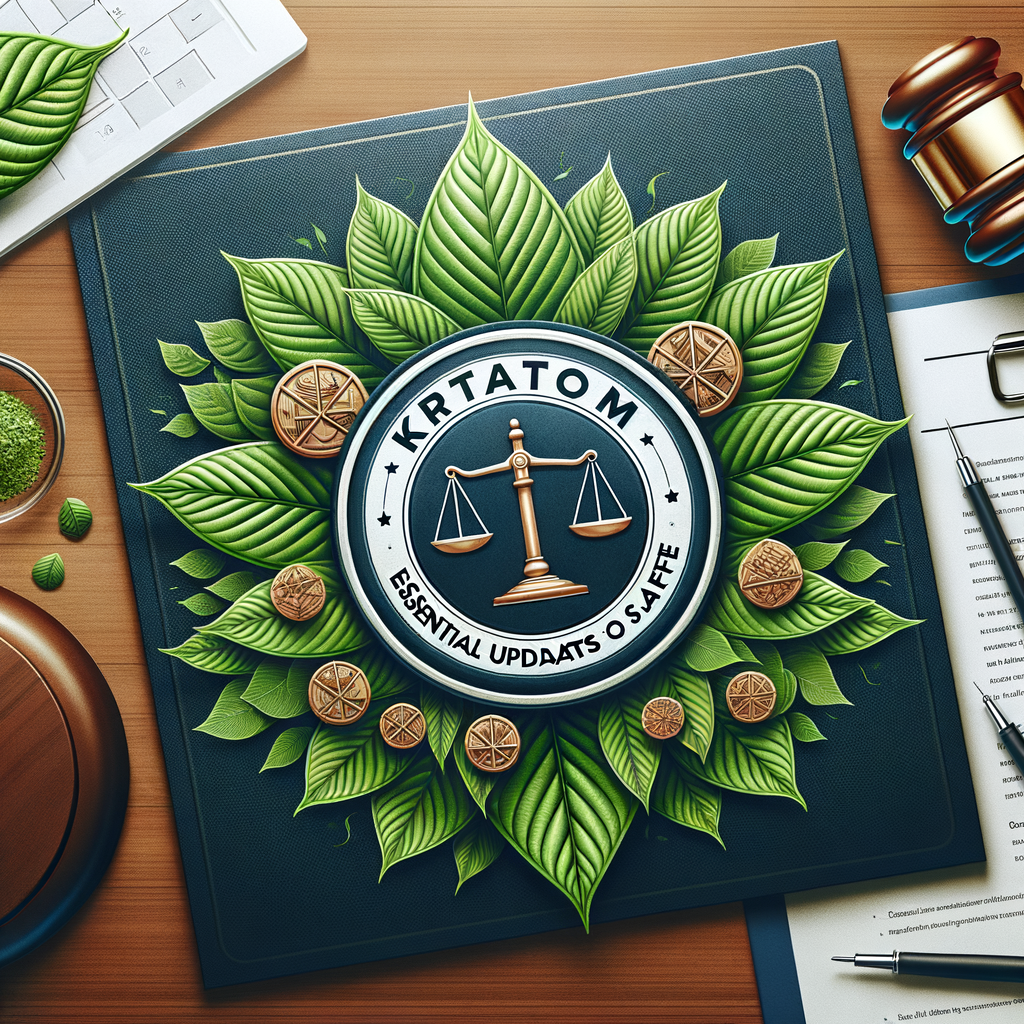
Kratom Regulations: Essential Updates for Safe Use
- Understanding Kratom: What Is It and Why Does It Matter?
- The Legal Landscape of Kratom in the U.S.
- State-Specific Regulations
- The FDA Stance on Kratom
- The Science Behind Kratom: Active Compounds
- Mitragynine and 7-Hydroxymitragynine
- Mitragynine
- 7-Hydroxymitragynine
- Health Risks and Side Effects of Kratom
- Long-Term Use Considerations
- Safe Usage Guidelines for Kratom
- Start Small
- Buy from Reputable Sources
- Follow Local Laws
- Consult with Healthcare Professionals
- Keep Records
- Kratom’s Role in Pain Management
- Comparative Analysis: Kratom vs. Opioids
- Navigating Kratom Withdrawals
- Withdrawal Symptoms
- The Future of Kratom Regulations
- The Need for Standardization
- Conclusion: The Path Forward
- FAQs
- References
Understanding Kratom: What Is It and Why Does It Matter?

Kratom, scientifically known as Mitragyna speciosa, is a tropical tree indigenous to Southeast Asia. The leaves of this tree have been used for centuries for their stimulant and sedative properties. Many people have turned to kratom for pain relief, coping with anxiety, or overcoming opioid dependence. However, despite its growing popularity, the use of kratom raises significant questions about safety and regulations.
As research continues, we see both praise and skepticism surrounding this plant’s use. Some users share positive experiences, while others caution against its potential risks. Thus, understanding the regulations surrounding kratom becomes vital for informed and safe usage.
The Legal Landscape of Kratom in the U.S.
Kratom’s legal status in the United States is a complicated topic. Currently, it sits in a gray area. While kratom is legal at the federal level, individual states have differing laws. Some states have embraced its use, while others have outright banned it. This patchwork of regulations creates confusion.
For instance, states like California and Texas allow kratom sales without restrictions, providing users with easy access. On the flip side, states like Alabama and Wisconsin have completely prohibited it. Therefore, it’s crucial for users to check their local laws before purchasing or consuming kratom.
State-Specific Regulations
Navigating the legal landscape requires understanding state-specific regulations. Below is a brief overview of some states and their kratom laws.
| State | Status |
|—————-|—————–|
| California | Legal |
| Florida | Legal |
| Alabama | Illegal |
| Wisconsin | Illegal |
| New York | Legal (Pending Review) |
This table illustrates how regulations can vary significantly from one place to another. In states where kratom is legal, vendors often sell it in health shops, smoke shops, or online.
The FDA Stance on Kratom
The U.S. Food and Drug Administration (FDA) maintains a cautious view on kratom. As early as 2016, the agency issued warnings about potential health risks associated with kratom use. The FDA has not approved kratom for any medical use. This lack of approval limits its legitimacy in the eyes of many healthcare professionals.
Furthermore, the FDA has consistently raised concerns over the unregulated nature of kratom products. Many vendors may not adhere to quality control standards, leading to contamination or mislabeling. Users may consume products that contain different alkaloid concentrations, making their effects unpredictable.
The Science Behind Kratom: Active Compounds
Kratom leaves contain several active compounds, with mitragynine and 7-hydroxymitragynine being the most studied. These compounds interact with the body’s opioid receptors and can mimic the effects of both opioids and stimulants, depending on the dosage.
Mitragynine and 7-Hydroxymitragynine
Mitragynine
– Effects: Analgesic, mood enhancer
– Dosage: Low doses often yield stimulating effects, while higher doses can be sedative
7-Hydroxymitragynine
– Effects: Stronger pain relief, potential for addiction
– Dosage: Generally considered the more potent compound
Understanding these compounds can help users gauge how kratom may affect them. For example, someone seeking pain relief might prefer higher doses, while another person wanting increased energy could opt for lower amounts.
Health Risks and Side Effects of Kratom
Though many users report positive experiences with kratom, it’s essential to recognize potential risks. Side effects can range from mild to severe. Common side effects include nausea, constipation, and dizziness. Some individuals may also experience more severe reactions, such as increased heart rate or seizures.
Long-Term Use Considerations
Long-term use can lead to dependence, withdrawal symptoms, and various health issues. Signs of kratom dependence include the following:
– Increased tolerance
– Withdrawal symptoms when not using
– Neglecting daily obligations
Recognizing these signs early can help users make informed decisions about their kratom consumption.
Safe Usage Guidelines for Kratom
Understanding how to use kratom safely can enhance its benefits while minimizing risks. Here are several guidelines to consider:
Start Small
Always begin with a low dose. This approach allows you to understand how your body reacts. Gradually increase the dose if needed.
Buy from Reputable Sources
Ensure you purchase kratom from vendors who practice transparency. Look for third-party testing results to verify product quality.
Follow Local Laws
Stay informed about the legal status of kratom in your area. Avoid any legal troubles by adhering to regulations.
Consult with Healthcare Professionals
If you’re considering kratom for a specific health condition, discuss it with your physician. They can provide insight tailored to your health needs.
Keep Records
Track your consumption and any effects experienced. This will help you better understand what works for you and what doesn’t.
Kratom’s Role in Pain Management
Many people turn to kratom for pain relief, especially those who seek alternatives to traditional opioids. Kratom may provide an effective solution for managing chronic pain. Its analgesic properties can help individuals navigate daily discomfort without the harsh side effects often associated with prescription pain medication.
Comparative Analysis: Kratom vs. Opioids
| Aspect | Kratom | Opioids |
|———————-|————————|———————–|
| Natural Source | Yes | No |
| Dependence Risk | Moderate | High |
| Side Effects | Nausea, dizziness | Nausea, constipation, addiction |
| Legal Status | Varied by state | Heavily regulated |
This comparison shows that while kratom presents an attractive alternative, its use isn’t without challenges. Users must weigh the benefits against potential risks.
Navigating Kratom Withdrawals
Just like pharmaceuticals, kratom may lead to withdrawal symptoms in some users. If you decide to stop using kratom, do so gradually. Cold turkey methods can lead to heightened withdrawal symptoms.
Withdrawal Symptoms
Common withdrawal symptoms include:
– Insomnia
– Irritability
– Muscle aches
Managing these symptoms requires support, both physically and emotionally. Consider speaking with healthcare professionals or support groups to ease the transition.
The Future of Kratom Regulations
As research grows, so does the conversation surrounding kratom regulations. Organizations like the American Kratom Association advocate for responsible use and stricter quality controls. Encouragingly, more states are considering legislative measures that could shape the industry further.
The Need for Standardization
Standardized regulations could protect consumers by ensuring product quality and safety. Establishing guidelines may also enhance credibility, allowing kratom’s beneficial aspects to shine. With ongoing public interest, it’s likely that kratom’s future will be flexible but focused on safety.
Conclusion: The Path Forward
As kratom remains a subject of debate, users must stay informed. Understanding the science, regulations, and potential risks ensures safer consumption. Being a responsible kratom user involves keeping up-to-date with laws, consulting healthcare professionals, and selecting high-quality products.
As the legal landscape continues to evolve, the conversation surrounding kratom will likely expand. By keeping abreast of developments and acting responsibly, you can navigate this complex environment more effectively.
FAQs
1. What is kratom used for?
Kratom is often used for pain relief, anxiety reduction, and managing withdrawal symptoms from opioids.
2. Is kratom legal in all states?
No, kratom’s legality varies by state. Some states have banned it, while others allow its use.
3. Can you get addicted to kratom?
Yes, long-term use can lead to dependence and withdrawal symptoms.
4. Are there safe dosages for kratom?
Beginners should start with low doses and gradually increase based on individual tolerance.
5. What side effects should I be aware of?
Common side effects include nausea, dizziness, and constipation. Severe reactions can occur, so caution is vital.
6. How can I find reputable suppliers?
Look for vendors that offer third-party testing results and customer reviews.
7. Does the FDA approve kratom for medical use?
No, the FDA has not approved kratom for any medical condition.
8. Can I use kratom with other medications?
Always consult a healthcare professional before combining kratom with medications.
9. How do I manage kratom withdrawal symptoms?
Gradually taper off kratom and consider seeking support from healthcare professionals.
10. What is the future of kratom legislation?
Ongoing research and advocacy may lead to standardized regulations and increased safety measures for kratom users.
References
– National Institutes of Health: Kratom (Mitragyna speciosa): A Review of the Evidence
– American Kratom Association: Kratom Legislative Updates
– U.S. Food and Drug Administration: FDA’s Public Health Warning on Kratom


